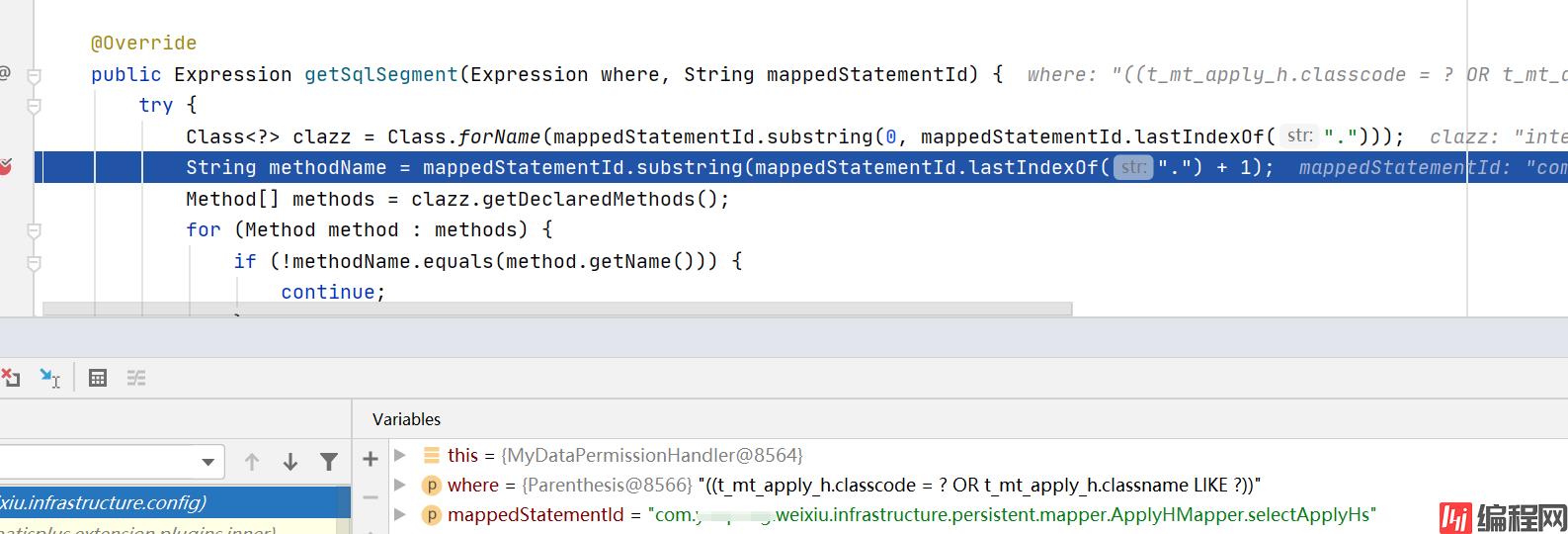Python 官方文档:入门教程 => 点击学习
目录前言一、源码分析二、使用案例尝试验证@InterceptorIgnore注解实践应用总结前言 数据权限因分页问题,不可能通过代码对数据进行过滤处理,只能在数据库语句进行处理,而如
数据权限因分页问题,不可能通过代码对数据进行过滤处理,只能在数据库语句进行处理,而如果每个查询都进行特殊处理的话,是个巨大的工作量,在网上找到了mybatis的一种解决方案。
package com.baomidou.mybatisplus.extension.plugins.inner;
import com.baomidou.mybatisplus.core.plugins.InterceptorIgnoreHelper;
import com.baomidou.mybatisplus.core.toolkit.PluginUtils;
import com.baomidou.mybatisplus.extension.parser.JsqlParserSupport;
import com.baomidou.mybatisplus.extension.plugins.handler.DataPermissionHandler;
import lombok.*;
import net.sf.jsqlparser.expression.Expression;
import net.sf.jsqlparser.statement.select.PlainSelect;
import net.sf.jsqlparser.statement.select.Select;
import net.sf.jsqlparser.statement.select.SelectBody;
import net.sf.jsqlparser.statement.select.SetOperationList;
import org.apache.ibatis.executor.Executor;
import org.apache.ibatis.mapping.BoundSql;
import org.apache.ibatis.mapping.MappedStatement;
import org.apache.ibatis.session.ResultHandler;
import org.apache.ibatis.session.RowBounds;
import java.sql.SQLException;
import java.util.List;
@Data
@NoArgsConstructor
@AllArgsConstructor
@ToString(callSuper = true)
@EqualsAndHashCode(callSuper = true)
@SuppressWarnings({"rawtypes"})
public class DataPermissionInterceptor extends JsqlParserSupport implements InnerInterceptor {
private DataPermissionHandler dataPermissionHandler;
@Override
public void beforeQuery(Executor executor, MappedStatement ms, Object parameter, RowBounds rowBounds, ResultHandler resultHandler, BoundSql boundSql) throws SQLException {
if (InterceptorIgnoreHelper.willIgnoreDataPermission(ms.getId())) return;
PluginUtils.MPBoundSql mpBs = PluginUtils.mpBoundSql(boundSql);
mpBs.sql(parserSingle(mpBs.sql(), ms.getId()));
}
@Override
protected void processSelect(Select select, int index, String sql, Object obj) {
SelectBody selectBody = select.getSelectBody();
if (selectBody instanceof PlainSelect) {
this.setWhere((PlainSelect) selectBody, (String) obj);
} else if (selectBody instanceof SetOperationList) {
SetOperationList setOperationList = (SetOperationList) selectBody;
List<SelectBody> selectBodyList = setOperationList.getSelects();
selectBodyList.forEach(s -> this.setWhere((PlainSelect) s, (String) obj));
}
}
protected void setWhere(PlainSelect plainSelect, String whereSegment) {
Expression sqlSegment = dataPermissionHandler.getSqlSegment(plainSelect.getWhere(), whereSegment);
if (null != sqlSegment) {
plainSelect.setWhere(sqlSegment);
}
}
}
mybatis-plus在gitee的仓库中,有人询问了如何使用DataPermissionInterceptor,下面有人给出了例子,一共分为两步,一是实现dataPermissionHandler接口,二是将实现添加到mybstis-plus的处理器中。他的例子中是根据不同权限类型拼接sql。
通用的方案是在所有的表中增加权限相关的字段,如部门、门店、租户等。实现dataPermissionHandler接口时较方便,可直接添加这几个字段的条件,无需查询数据库。
public class DataPermissionHandlerImpl implements DataPermissionHandler {
@Override
public Expression getSqlSegment(Expression where, String mappedStatementId) {
try {
Class<?> clazz = Class.forName(mappedStatementId.substring(0, mappedStatementId.lastIndexOf(".")));
String methodName = mappedStatementId.substring(mappedStatementId.lastIndexOf(".") + 1);
Method[] methods = clazz.getDeclaredMethods();
for (Method method : methods) {
DataPermission annotation = method.getAnnotation(DataPermission.class);
if (ObjectUtils.isNotEmpty(annotation) && (method.getName().equals(methodName) || (method.getName() + "_COUNT").equals(methodName))) {
// 获取当前的用户
LoginUser loginUser = springUtils.getBean(TokenService.class).getLoginUser(ServletUtils.getRequest());
if (ObjectUtils.isNotEmpty(loginUser) && ObjectUtils.isNotEmpty(loginUser.getUser()) && !loginUser.getUser().isAdmin()) {
return dataScopeFilter(loginUser.getUser(), annotation.value(), where);
}
}
}
} catch (ClassNotFoundException e) {
e.printStackTrace();
}
return where;
}
public static Expression dataScopeFilter(SysUser user, String tableAlias, Expression where) {
Expression expression = null;
for (SysRole role : user.getRoles()) {
String dataScope = role.getDataScope();
if (DataScopeAspect.DATA_SCOPE_ALL.equals(dataScope)) {
return where;
}
if (DataScopeAspect.DATA_SCOPE_CUSTOM.equals(dataScope)) {
InExpression inExpression = new InExpression();
inExpression.setLeftExpression(buildColumn(tableAlias, "dept_id"));
SubSelect subSelect = new SubSelect();
PlainSelect select = new PlainSelect();
select.setSelectItems(Collections.singletonList(new SelectExpressionItem(new Column("dept_id"))));
select.setFromItem(new Table("sys_role_dept"));
EqualsTo equalsTo = new EqualsTo();
equalsTo.setLeftExpression(new Column("role_id"));
equalsTo.setRightExpression(new LongValue(role.getRoleId()));
select.setWhere(equalsTo);
subSelect.setSelectBody(select);
inExpression.setRightExpression(subSelect);
expression = ObjectUtils.isNotEmpty(expression) ? new OrExpression(expression, inExpression) : inExpression;
}
if (DataScopeAspect.DATA_SCOPE_DEPT.equals(dataScope)) {
EqualsTo equalsTo = new EqualsTo();
equalsTo.setLeftExpression(buildColumn(tableAlias, "dept_id"));
equalsTo.setRightExpression(new LongValue(user.getDeptId()));
expression = ObjectUtils.isNotEmpty(expression) ? new OrExpression(expression, equalsTo) : equalsTo;
}
if (DataScopeAspect.DATA_SCOPE_DEPT_AND_CHILD.equals(dataScope)) {
InExpression inExpression = new InExpression();
inExpression.setLeftExpression(buildColumn(tableAlias, "dept_id"));
SubSelect subSelect = new SubSelect();
PlainSelect select = new PlainSelect();
select.setSelectItems(Collections.singletonList(new SelectExpressionItem(new Column("dept_id"))));
select.setFromItem(new Table("sys_dept"));
EqualsTo equalsTo = new EqualsTo();
equalsTo.setLeftExpression(new Column("dept_id"));
equalsTo.setRightExpression(new LongValue(user.getDeptId()));
Function function = new Function();
function.setName("find_in_set");
function.setParameters(new ExpressionList(new LongValue(user.getDeptId()) , new Column("ancestors")));
select.setWhere(new OrExpression(equalsTo, function));
subSelect.setSelectBody(select);
inExpression.setRightExpression(subSelect);
expression = ObjectUtils.isNotEmpty(expression) ? new OrExpression(expression, inExpression) : inExpression;
}
if (DataScopeAspect.DATA_SCOPE_SELF.equals(dataScope)) {
EqualsTo equalsTo = new EqualsTo();
equalsTo.setLeftExpression(buildColumn(tableAlias, "create_by"));
equalsTo.setRightExpression(new StringValue(user.getUserName()));
expression = ObjectUtils.isNotEmpty(expression) ? new OrExpression(expression, equalsTo) : equalsTo;
}
}
return ObjectUtils.isNotEmpty(where) ? new AndExpression(where, new Parenthesis(expression)) : expression;
}
public static Column buildColumn(String tableAlias, String columnName) {
if (StringUtils.isNotEmpty(tableAlias)) {
columnName = tableAlias + "." + columnName;
}
return new Column(columnName);
}
}
// 自定义数据权限
interceptor.addInnerInterceptor(new DataPermissionInterceptor(new DataPermissionHandlerImpl()));
DataPermissionHandler 接口

可以看到DataPermissionHandler 接口使用中,传递来的参数是什么。
| 参数 | 含义 |
|---|---|
| where | 为当前sql已有的where条件 |
| mappedStatementId | 为mapper中定义的方法的路径 |
拦截忽略注解 @InterceptorIgnore
| 属性名 | 类型 | 默认值 | 描述 |
|---|---|---|---|
| tenantLine | String | “” | 行级租户 |
| dynamicTableName | String | “” | 动态表名 |
| blockAttack | String | “” | 攻击 SQL 阻断解析器,防止全表更新与删除 |
| illegalSql | String | “” | 垃圾SQL拦截 |
在维修小程序中,我使用了此方案。如下是我的代码:
@Component
public class MyDataPermissionHandler implements DataPermissionHandler {
@Autowired
@Lazy
private UserRepository userRepository;
@Override
public Expression getSqlSegment(Expression where, String mappedStatementId) {
try {
Class<?> clazz = Class.forName(mappedStatementId.substring(0, mappedStatementId.lastIndexOf(".")));
String methodName = mappedStatementId.substring(mappedStatementId.lastIndexOf(".") + 1);
Method[] methods = clazz.getDeclaredMethods();
for (Method method : methods) {
if (!methodName.equals(method.getName())) {
continue;
}
// 获取自定义注解,无此注解则不控制数据权限
CustomDataPermission annotation = method.getAnnotation(CustomDataPermission.class);
if (annotation == null) {
continue;
}
// 自定义的用户上下文,获取到用户的id
ContextUserDetails contextUserDetails = UserDetailsContextHolder.getContextUserDetails();
String userId = contextUserDetails.getId();
User user = userRepository.selectUserById(userId);
// 如果是特权用户,不控制数据权限
if (Constants.ADMIN_RULE == user.getAdminuser()) {
return where;
}
// 员工用户
if (UserTypeEnum.USER_TYPE_EMPLOYEE.getCode().equals(user.getUsertype())) {
// 员工用户的权限字段
String field = annotation.field().getValue();
// 单据类型
String billType = annotation.billType().getFuncno();
// 操作类型
OperationTypeEnum operationType = annotation.operation();
// 权限字段为空则为不控制数据权限
if (StringUtils.isNotEmpty(field)) {
List<DataPermission> dataPermissions = userRepository.selectUserFuncnoDataPermission(userId, billType);
if (dataPermissions.size() == 0) {
// 没数据权限,但有功能权限则取所有数据
return where;
}
// 构建in表达式
InExpression inExpression = new InExpression();
inExpression.setLeftExpression(new Column(field));
List<Expression> conditions = null;
switch(operationType) {
case SELECT:
conditions = dataPermissions.stream().map(res -> new StringValue(res.getStkid())).collect(Collectors.toList());
break;
case INSERT:
conditions = dataPermissions.stream().filter(DataPermission::isAddright).map(res -> new StringValue(res.getStkid())).collect(Collectors.toList());
break;
case UPDATE:
conditions = dataPermissions.stream().filter(DataPermission::isModright).map(res -> new StringValue(res.getStkid())).collect(Collectors.toList());
break;
case APPROVE:
conditions = dataPermissions.stream().filter(DataPermission::isCheckright).map(res -> new StringValue(res.getStkid())).collect(Collectors.toList());
break;
default:
break;
}
if (conditions == null) {
return where;
}
conditions.add(new StringValue(Constants.ALL_STORE));
ItemsList itemsList = new ExpressionList(conditions);
inExpression.setRightItemsList(itemsList);
if (where == null) {
return inExpression;
}
return new AndExpression(where, inExpression);
} else {
return where;
}
} else {
// 供应商用户的权限字段
String field = annotation.vendorfield().getValue();
if (StringUtils.isNotEmpty(field)) {
// 供应商如果控制权限,则只能看到自己的单据。直接使用EqualsTo
EqualsTo equalsTo = new EqualsTo();
equalsTo.setLeftExpression(new Column(field));
equalsTo.setRightExpression(new StringValue(userId));
if (where == null) {
return equalsTo;
}
// 创建 AND 表达式 拼接Where 和 = 表达式
return new AndExpression(where, equalsTo);
} else {
return where;
}
}
}
} catch (ClassNotFoundException e) {
e.printStackTrace();
}
return where;
}
}
@Configuration
public class MybatisConfig {
@Autowired
private MyDataPermissionHandler myDataPermissionHandler;
@Bean
public MybatisPlusInterceptor mybatisPlusInterceptor() {
MybatisPlusInterceptor interceptor = new MybatisPlusInterceptor();
// 添加数据权限插件
DataPermissionInterceptor dataPermissionInterceptor = new DataPermissionInterceptor();
// 添加自定义的数据权限处理器
dataPermissionInterceptor.setDataPermissionHandler(myDataPermissionHandler);
interceptor.addInnerInterceptor(dataPermissionInterceptor);
// 分页插件
//interceptor.addInnerInterceptor(new PaginationInnerInterceptor(DbType.SQL_SERVER));
return interceptor;
}
}
因为维修小程序相当于一个外挂程序,他的权限控制延用了七八年前程序的方案,设计的较为复杂,也有现成获取数据的存储过程供我们使用,此处做了一些特殊处理。增加了自定义注解、dataPermissionHandler接口实现类查询了数据库调用存储过程获取权限信息等。
自定义注解
@Target({ElementType.METHOD, ElementType.TYPE})
@Retention(RetentionPolicy.RUNTIME)
public @interface CustomDataPermission {
PermissionFieldEnum field();
PermissionFieldEnum vendorfield();
BillTypeEnum billType();
OperationTypeEnum operation();
}
使用注解
@Mapper
public interface ApplyHMapper extends BaseMapper<ApplyHPo> {
@CustomDataPermission(field = PermissionFieldEnum.FIELD_STKID,
vendorfield = PermissionFieldEnum.FIELD_EMPTY,
billType = BillTypeEnum.APPLY_BILL,
operation = OperationTypeEnum.SELECT)
Page<ApplyHPo> selectApplyHs(IPage<ApplyHPo> page, @Param(Constants.WRAPPER) QueryWrapper<ApplyHPo> queryWrapper);
Page<ApplyHPo> selectApplyHsForVendor(IPage<ApplyHPo> page, @Param("vendorid") String vendorid, @Param(Constants.WRAPPER) QueryWrapper<ApplyHPo> queryWrapper);
@CustomDataPermission(field = PermissionFieldEnum.FIELD_STKID,
vendorfield = PermissionFieldEnum.FIELD_EMPTY,
billType = BillTypeEnum.APPLY_BILL,
operation = OperationTypeEnum.SELECT)
ApplyHPo selectApplyH(@Param("billNo") String billNo);
@InterceptorIgnore
ApplyHPo selectApplyHNoPermission(@Param("billNo") String billNo);
void saveApplyH(ApplyHPo applyHPo);
}
最终的效果
2022-04-24 09:14:52.878 DEBUG 29254 --- [NIO-8086-exec-2] c.y.w.i.p.m.ApplyHMapper.selectApplyHs : ==> select * from t_mt_apply_h WHERE stkid IN ('0025', 'all')
以上就是今天要讲的内容,本文仅仅简单介绍了Mybatis-plus数据权限接口DataPermissionInterceptor的一种实现方式,没有过多的深入研究。
部分内容参考:
Mybatis-Plus入门系列(3)- MybatisPlus之数据权限插件DataPermissionInterceptor
@InterceptorIgnore
到此这篇关于Mybatis-plus数据权限DataPermissionInterceptor实现的文章就介绍到这了,更多相关Mybatis-plus DataPermissionInterceptor内容请搜索编程网以前的文章或继续浏览下面的相关文章希望大家以后多多支持编程网!
--结束END--
本文标题: Mybatis-plus数据权限DataPermissionInterceptor实现
本文链接: https://www.lsjlt.com/news/153935.html(转载时请注明来源链接)
有问题或投稿请发送至: 邮箱/279061341@qq.com QQ/279061341
下载Word文档到电脑,方便收藏和打印~
2024-03-01
2024-03-01
2024-03-01
2024-02-29
2024-02-29
2024-02-29
2024-02-29
2024-02-29
2024-02-29
2024-02-29
回答
回答
回答
回答
回答
回答
回答
回答
回答
回答
0